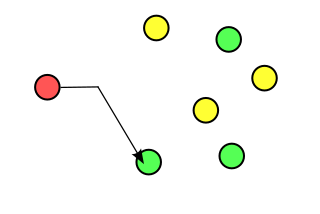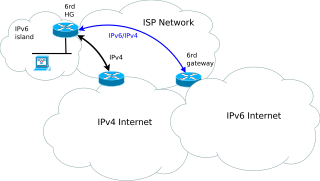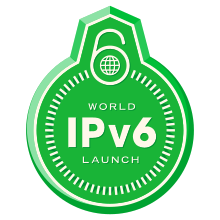
The Internet is the global system of interconnected computer networks that uses the Internet protocol suite (TCP/IP) to communicate between networks and devices. It is a network of networks that consists of private, public, academic, business, and government networks of local to global scope, linked by a broad array of electronic, wireless, and optical networking technologies. The Internet carries a vast range of information resources and services, such as the interlinked hypertext documents and applications of the World Wide Web (WWW), electronic mail, telephony, and file sharing.

Internet Protocol version 4 (IPv4) is the fourth version of the Internet Protocol (IP). It is one of the core protocols of standards-based internetworking methods in the Internet and other packet-switched networks. IPv4 was the first version deployed for production on SATNET in 1982 and on the ARPANET in January 1983. It is still used to route most Internet traffic today, even with the ongoing deployment of Internet Protocol version 6 (IPv6), its successor.

Internet Protocol version 6 (IPv6) is the most recent version of the Internet Protocol (IP), the communications protocol that provides an identification and location system for computers on networks and routes traffic across the Internet. IPv6 was developed by the Internet Engineering Task Force (IETF) to deal with the long-anticipated problem of IPv4 address exhaustion, and was intended to replace IPv4. In December 1998, IPv6 became a Draft Standard for the IETF, which subsequently ratified it as an Internet Standard on 14 July 2017.
The Internet Protocol (IP) is the network layer communications protocol in the Internet protocol suite for relaying datagrams across network boundaries. Its routing function enables internetworking, and essentially establishes the Internet.
A multicast address is a logical identifier for a group of hosts in a computer network that are available to process datagrams or frames intended to be multicast for a designated network service. Multicast addressing can be used in the link layer, such as Ethernet multicast, and at the internet layer for Internet Protocol Version 4 (IPv4) or Version 6 (IPv6) multicast.
A virtual private network (VPN) is a mechanism for creating a secure connection between a computing device and a computer network, or between two networks, using an insecure communication medium such as the public Internet.

A subnetwork, or subnet, is a logical subdivision of an IP network. The practice of dividing a network into two or more networks is called subnetting.

Anycast is a network addressing and routing methodology in which a single IP address is shared by devices in multiple locations. Routers direct packets addressed to this destination to the location nearest the sender, using their normal decision-making algorithms, typically the lowest number of BGP network hops. Anycast routing is widely used by content delivery networks such as web and name servers, to bring their content closer to end users.

The Toronto Internet Exchange Community (TorIX) is a not-for-profit Internet Exchange Point (IXP) located in a carrier hotel at 151 Front Street West, Equinix's TR2 data centre at 45 Parliament Street and 905 King Street West in Toronto, Ontario, Canada. As of March 2021, TorIX has 259 unique autonomous systems representing 285 peer connections and peak traffic rates of 1.344 Tbps, making it the largest IXP in Canada. According to Wikipedia's List of Internet Exchange Points by Size, TorIX is the 16th largest IXP in the world in numbers of peers, and 17th in the world in traffic averages. The Exchange is organized and run by industry professionals in voluntary capacity.

IPv4 address exhaustion is the depletion of the pool of unallocated IPv4 addresses. Because the original Internet architecture had fewer than 4.3 billion addresses available, depletion has been anticipated since the late 1980s when the Internet started experiencing dramatic growth. This depletion is one of the reasons for the development and deployment of its successor protocol, IPv6. IPv4 and IPv6 coexist on the Internet.
The China Next Generation Internet (CNGI) project is an ongoing plan for the accelerated rollout and application of the IPv6 protocol nationwide.
An IPv6 transition mechanism is a technology that facilitates the transitioning of the Internet from the Internet Protocol version 4 (IPv4) infrastructure in use since 1983 to the successor addressing and routing system of Internet Protocol Version 6 (IPv6). As IPv4 and IPv6 networks are not directly interoperable, transition technologies are designed to permit hosts on either network type to communicate with any other host.
The deployment of IPv6, the latest version of the Internet Protocol (IP), has been in progress since the mid-2000s. IPv6 was designed as the successor protocol for IPv4 with an expanded addressing space. IPv4, which has been in use since 1982, is in the final stages of exhausting its unallocated address space, but still carries most Internet traffic.
Proxy Mobile IPv6 is a network-based mobility management protocol standardized by IETF and is specified in RFC 5213. It is a protocol for building a common and access technology independent of mobile core networks, accommodating various access technologies such as WiMAX, 3GPP, 3GPP2 and WLAN based access architectures. Proxy Mobile IPv6 is the only network-based mobility management protocol standardized by IETF.
Hurricane Electric is a global Internet service provider offering Internet transit, tools, and network applications, as well as data center colocation and hosting services at two locations in Fremont, California, where the company is based.

6rd is a mechanism to facilitate IPv6 rapid deployment across IPv4 infrastructures of Internet service providers (ISPs).
NAT64 is an IPv6 transition mechanism that facilitates communication between IPv6 and IPv4 hosts by using a form of network address translation (NAT). The NAT64 gateway is a translator between IPv4 and IPv6 protocols, for which function it needs at least one IPv4 address and an IPv6 network segment comprising a 32-bit address space. The "well-known prefix" reserved for this service is 64:ff9b::/96.
In the field of IPv6 deployment, IPv6 brokenness was bad behavior seen in early tunneled or dual stack IPv6 deployments where unreliable or bogus IPv6 connectivity is chosen in preference to working IPv4 connectivity. This often resulted in long delays in web page loading, where the user had to wait for each attempted IPv6 connection to time out before the IPv4 connection was tried. These timeouts ranged from being near-instantaneous in the best cases, to taking anywhere between four seconds to three minutes.

Rémi Després is a French engineer and entrepreneur known for his contributions on data networking.
Happy Eyeballs is an algorithm published by the IETF that makes dual-stack applications more responsive to users by attempting to connect using both IPv4 and IPv6 at the same time, thus minimizing common problems experienced by users with imperfect IPv6 connections or setups. The name "happy eyeballs" derives from the term "eyeball" to describe endpoints which represent human Internet end-users, as opposed to servers.









